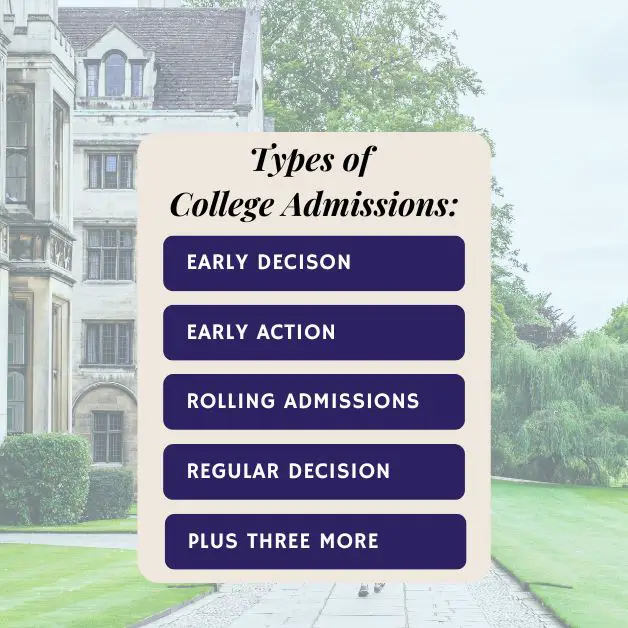High school seniors will be receiving many invitations to college admissions information sessions over the next few months. One thing that your family needs to decide is whether or not your college-bound student will apply early decision or early action to any colleges since there are several types of admission.
Is your family questioning if applying early decision is worth it since it is a binding commitment? If so, I want to break down four admission types so that you can make the best decision for your high school senior.

Types of College Admissions
Applying Early Decision
Many private colleges offer early decision admissions. The early decision applications demonstrate to the school’s admissions committee that their school is a student’s first school choice.
If a student is accepted through early decision, then it’s a binding agreement. That means that they will attend that school if accepted and are awarded a financial aid package that allows them to be able to attend that school. They will then withdraw any other regular admissions applications that they may have submitted to other schools.
If your teen is certain that a particular school is their number one pick, they can consider applying as an early decision student. Students can not apply to more than one college under early decision. Although you need to check the prospective school’s deadline, November 1st is the general deadline for early decision applicants.
Early Decision Benefits
1. Early decision applicants are notified of a school’s admissions decision before regular admission applicants.
2. The early decision applicants receive an early financial aid package including any scholarships that the school is able to offer. [Note that students will still need to submit the Free Application for Federal Student Aid (FAFSA) and the CSS Profile in order to receive their financial aid package.]
3. It reduces the amount of stress and anxiety (time-wise at least) that students experience searching for a college during their senior year of high school. Many early decision applicants are notified by mid-December.
4. Some schools give additional perks to early decision applicants. Special offers include things like priority financial aid, early Fall 2023 registration, as well as early move-in to residence halls and early room selection for students who will live on campus.
(One university that sent my son information last year even offered free parking/to waive the school’s parking permit fee for the first year if he applied early decision.)
Additional Notes:
*Some schools have a second round of early decision applications in January.
*Legacy and recruited athletes are usually required to apply early decision. “Legacy” applicants are prospective students with some kind of family tie to a college or university.
*Overall, applying early decision can be an advantage. It can be especially helpful when applying to larger schools and universities.
Early Action Admissions
Another option for many schools is to apply early action. Many private and public schools offer this non-binding possibility.
Similar to the early decision, the application deadlines are usually November 1st. Early action admissions are good if the student really likes their grades from their junior year of high school and wants to be judged by them.
Unlike early decision admissions, early action applicants are not bound to the college that they apply to for early action. They don’t have to commit to attending a particular college if they are accepted early action. They can still choose to go to another college. Students can also apply early action to multiple colleges.
If a student has a strong interest in attending a particular school, early action is great. They will receive an admission decision months before regular decision applications – giving them plenty of time to make a final decision. (Students will usually receive a response in January.)
Rolling Admissions
With this option, schools consider applications as they receive them. Many public schools offer this non-binding type of admission.
The earlier that students submit their applications, test scores and other materials, the sooner their applications will be reviewed. I encourage applying as soon as possible so that a decision can be made – by both the school and the student.
Regular Decision
Students can also apply to colleges as regular decision applicants. Usually, students will get a decision on their application around mid-March.
Other Admission Types
-Open Admissions: All students who apply are accepted until the incoming class is full.
–Single-Choice Early Action: This early decision alternative is non-binding. Students aren’t allowed to apply to other schools during the early action period with this selection though.
–Deferred Admission: Some colleges offer this decision to students who want to take a gap year. It allows them to postpone their enrollment (usually) for up to one year.
I hope that knowing your family’s different options helps you to make a decision regarding the type of college admissions to pursue.
If my son had a school that he definitely (without a doubt) wanted to attend more than any other school, then I would have encouraged him to apply early decision and get it out of the way. He didn’t so he applied as a regular decision applicant. It’s always good to have multiple courses of action!
One last reminder: Be sure to check with each prospective school to get their application deadlines. They could be earlier or later than the norms mentioned in this post.
If you found this post helpful, please share it. Thanks!
1 thought on “Early, Rolling, Regular: Which Type of College Admissions Is Best?”
Comments are closed.